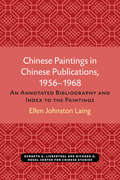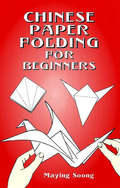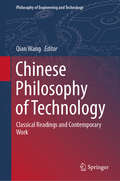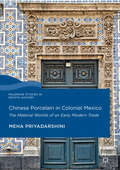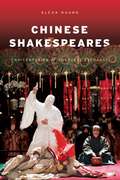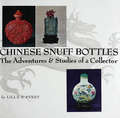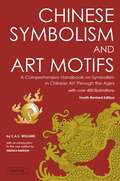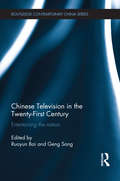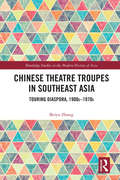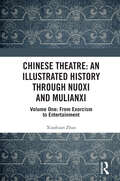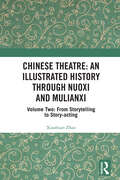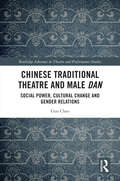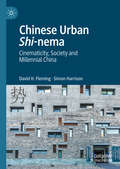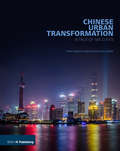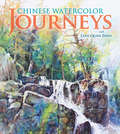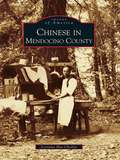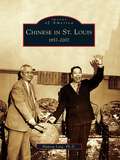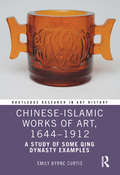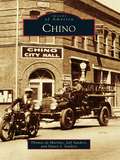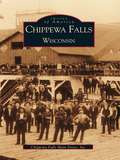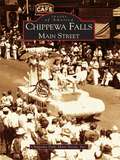- Table View
- List View
Chinese Paintings in Chinese Publications, 1956–1968: An Annotated Bibliography and Index to the Paintings (Michigan Monographs In Chinese Studies #6)
by Ellen Johnston LaingThis bibliography includes publications issued between 1956 and August 1968 that reproduce Chinese paintings now in Chinese public or private collections. The great majority of these publications were produced in Mainland China, Taiwan, Hong Kong, or Japan. Each publication included in the bibliography has been provided with a detailed physical description of the publication itself: the amounts of text , the number of plates in color and in monochrome, and a general evaluation of the quality of the reproductions. The title by which each work is referred to in the index is included at the end of each entry.
Chinese Paper Folding for Beginners (Dover Origami Papercraft Ser.)
by Maying SoongThough nowadays people usually refer to paper folding by its Japanese name, origami, the art most likely originated in China. Even today, youngsters in that country are taught this craft at a very early age by mothers and grandmothers.In this charming, instructive book, the author shares her knowledge of this rewarding craft by providing clear instructions and simple diagrams for folding gaily colored part hats, a pagida-shaped bookmark, toy boats made of waterproof paper, decorative candy boxes, a bird with wings that flap when its tail is pushed in and out, a Chinese fishing boat, a monkey, steamboats — even a three-piece living room set and other items of tiny furniture for a doll's house. All can be made without using scissors or paste, and projects are arranged from easiest to those requiring more skill.Children and adults alike will find this book fascinating and will be delighted by the imaginative works they're able to create from a single sheet of paper.
Chinese Philosophy of Technology: Classical Readings and Contemporary Work (Philosophy of Engineering and Technology #34)
by Qian WangThis book gathers essays that introduce the ideological advances in the philosophy of engineering and technology in contemporary China. It particularly focuses on China’s distinctive concepts and methods, revealing different views and academic debates to offer readers a comprehensive overview of this important field.The contributors present unique perspectives based on practical problems and traditional philosophy, examining such issues and concepts as axiology and theories of process, the difference between engineering activities and technology activities, and the core of the relationship between “Dao” and “Technique.”Other essays cover the ethics of technology, practical wisdom (phronesis) and practical reasoning, as well as creative concepts and methods concerning the philosophical problems in high technology, architectural technology, and technological innovation. The authors also consider more general issues in the field.This book compiles the relevant research achievements of Chinese scholars in various time periods. Some authors have revised and translated into English papers published in Chinese, while others present their research in English specifically for this study. An annotated bibliography of the major publications in the field completes this collection.
Chinese Porcelain in Colonial Mexico: The Material Worlds of an Early Modern Trade (Palgrave Studies in Pacific History)
by Meha PriyadarshiniThis book follows Chinese porcelain through the commodity chain, from its production in China to trade with Spanish Merchants in Manila, and to its eventual adoption by colonial society in Mexico. As trade connections increased in the early modern period, porcelain became an immensely popular and global product. This study focuses on one of the most exported objects, the guan. It shows how this porcelain jar was produced, made accessible across vast distances and how designs were borrowed and transformed into new creations within different artistic cultures. While people had increased access to global markets and products, this book argues that this new connectivity could engender more local outlooks and even heightened isolation in some places. It looks beyond the guan to the broader context of transpacific trade during this period, highlighting the importance and impact of Asian commodities in Spanish America.
Chinese Shakespeares: Two Centuries of Cultural Exchange (Global Chinese Culture)
by Alexa HuangFor close to two hundred years, the ideas of Shakespeare have inspired incredible work in the literature, fiction, theater, and cinema of China, Taiwan, and Hong Kong. From the novels of Lao She and Lin Shu to Lu Xun's search for a Chinese "Shakespeare," and from Feng Xiaogang's martial arts films to labor camp memoirs, Soviet-Chinese theater, Chinese opera in Europe, and silent film, Shakespeare has been put to work in unexpected places, yielding a rich trove of transnational imagery and paradoxical citations in popular and political culture. Chinese Shakespeares is the first book to concentrate on both Shakespearean performance and Shakespeare's appearance in Sinophone culture and their ambiguous relationship to the postcolonial question. Substantiated by case studies of major cultural events and texts from the first Opium War in 1839 to our times, Chinese Shakespeares theorizes competing visions of "China" and "Shakespeare" in the global cultural marketplace and challenges the logic of fidelity-based criticism and the myth of cultural exclusivity. In her critique of the locality and ideological investments of authenticity in nationalism, modernity, Marxism, and personal identities, Huang reveals the truly transformative power of Chinese Shakespeares.
Chinese Snuff Bottles
by Lilla S. PerryThis title was originally published in print form by Tuttle Publishing in 1960This book is not only an invaluable document for all interested in the history of Chinese art, but also a lucid and fascinating guidebook for the collector or would be collector, both of snuff bottles and other products of Chinese craftsmanship.
Chinese Symbolism and Art Motifs
by Charles Alfred WilliamsGain a deeper appreciation for Chinese art and architecture by understanding its symbols. The Yin and Yang, dragon, phoenix, five elements, and other symbols are explained in their historical and cultural context. Chinese Symbolism and Art Motifs also includes articles on Chinese beliefs, customs, arts and crafts, foods, agriculture and medicine.Originally published in 1941, this is the standard reference book, with over 400 illustrations to help clarify and define this ancient, complex culture.
Chinese Symbolism and Art Motifs
by Charles Alfred WilliamsGain a deeper appreciation for Chinese art and architecture by understanding its symbols. The Yin and Yang, dragon, phoenix, five elements, and other symbols are explained in their historical and cultural context. Chinese Symbolism and Art Motifs also includes articles on Chinese beliefs, customs, arts and crafts, foods, agriculture and medicine.Originally published in 1941, this is the standard reference book, with over 400 illustrations to help clarify and define this ancient, complex culture.
Chinese Television in the Twenty-First Century: Entertaining the Nation (Routledge Contemporary China Series)
by Ruoyun Bai Geng SongThe past two decades witnessed the rise of television entertainment in China. Although television networks are still state-owned and Party-controlled in China, the ideological landscape of television programs has become increasingly diverse and even paradoxical, simultaneously subservient and defiant, nationalistic and cosmopolitan, moralistic and fun-loving, extravagant and mundane. Studying Chinese television as a key node in the network of power relationships, therefore, provides us with a unique opportunity to understand the tension-fraught and , paradox-permeated conditions of Chinese post-socialism. This book argues for a serious engagement with television entertainment. rethinking, It addresses the following questions. How is entertainment television politically and culturally significant in the Chinese context? How have political, industrial, and technological changes in the 2000s affected the way Chinese television relates to the state and society? How can we think of media regulation and censorship without perpetuating the myth of a self-serving authoritarian regime vs. a subdued cultural workforce? What do popular televisual texts tell us about the unsettled and reconfigured relations between commercial television and the state? The book presents a number of studies of popular television programs that are sensitive to the changing production and regulatory contexts for Chinese television in the twenty-first century. As an interdisciplinary study of the television industry, this book covers a number of important issues in China today, such as censorship, nationalism, consumerism, social justice, and the central and local authorities. As such, it will appeal to a broad audience including students and scholars of Chinese culture and society, media studies, television studies, and cultural studies.
Chinese Theatre Troupes in Southeast Asia: Touring Diaspora, 1900s–1970s (Routledge Studies in the Modern History of Asia)
by Beiyu ZhangA detailed account of the cultural history of the Chinese diaspora, with a focus on the performers and audiences who were involved in the making of Chinese performing cultures in Southeast Asia. Focusing on five different kinds of theatre troupes from China and their respective travels in Singapore, Bangkok, Malaya and Hong Kong, Zhang examines their different travelling experiences and divergent cultural practices. She thus sheds light on how transnational mobility was embodied, practised and circumscribed in the course of troupes’ travelling, sojourning and interacting with diasporic communities. These troupes communicated diverse discourses and ideologies influenced by different social political movements in China, and these meanings were further altered by transmission. By unpacking multiple ways of performing Chineseness that was determined by changing time-space constructions, this volume provides valuable insight for scholars of the Chinese Diaspora, Transnational History and Performing Arts in Asia.
Chinese Theatre: Volume One: From Exorcism to Entertainment
by Xioahuan ZhaoChinese Theatre: An Illustrated History Through Nuoxi and Mulianxi is the first book in any language entirely devoted to a historical inquiry into Chinese theatre through Nuoxi and Mulianxi, the two most representative and predominant forms of Chinese temple theatre. With a view to evaluating the role of temple theatre in the development of xiqu or traditional Chinese theatre and drama from myth to ritual to ritual drama to drama, Volume One provides a panoramic perspective that allows every aspect of Nuoxi to be considered, not in the margins of xiqu but in and of itself. Thus, this volume traces xiqu history from its shamanic roots in exorcism rituals of Nuo to various forms of ritual and theatrical performance presented at temple fairs, during community and calendrical festivals or for ceremonial functions over the course of imperial history, and into the twenty-first century, followed by an exploration of the scriptural origins and oral traditions of Mulianxi, with pivotal forms and functions of Nuoxi and Mulian storytelling, examined, explicated and illustrated in association with the development of corresponding genres of Chines performance literature and performing arts. This is an interdisciplinary book project that is aimed to help researchers and students of theatre history understand the ritual origins of Chinese theatre and the dynamic relationships among myth, ritual, religion, and theatre.
Chinese Theatre: Volume Two: From Storytelling to Story-acting
by Xiaohuan ZhaoChinese Theatre: An Illustrated History Through Nuoxi and Mulianxi is the first book in any language entirely devoted to a historical inquiry into Chinese theatre through Nuoxi and Mulianxi, the two most representative and predominant forms of Chinese temple theatre. Volume Two is a continuation of the historical inquiry into Chinese theatre with focus shifted from Mulian storytelling to Mulian story-acting. Thus, this volume traces the historical trajectory of xiqu from Northern dramas to Southern dramas and from elite court theatre to mass regional theatre with pivotal forms and functions of Mulianxi examined, explicated and illustrated in association with the development of corresponding genres of xiqu. In so doing, every aspect of Mulianxi is considered not in the margins of xiqu but in and of itself. While this volume is primarily concerned with Mulianxi, references are also made to other forms of Chinese performing arts and temple theatre, Nuoxi in particular, as Mulianxi has been performed since the twelfth century as, or in company with, Nuoxi, to cleanse the community of evil spirits and epidemic diseases. This is an interdisciplinary book project that is aimed to help researchers and students of theatre history understand the ritual origins of Chinese theatre and the dynamic relationships among myth, ritual, religion and theatre.
Chinese Traditional Theatre and Male Dan: Social Power, Cultural Change and Gender Relations (Routledge Advances in Theatre & Performance Studies)
by Guo ChaoThis book examines male dan, a male actor who performs female roles in Chinese theatre. Through the rise, fall and tenuous survival of male dan in Chinese history, Guo Chao reflects the transformations in the social zeitgeist in China, especially the politics of gender and sexuality. The breadth of this study reflects a diversified set of sources, ranging from classical to contemporary texts (texts of jingju plays, memoirs, collections of notation books) and other commentaries and critical evaluations of dan actors (in both English and Chinese languages), to video and audio materials, films, and personal interviews. This book will be of great interest to students and scholars of East Asian/Chinese studies across the fields of theatre, history, culture, and literature.
Chinese Urban Shi-nema: Cinematicity, Society and Millennial China
by Simon Harrison David H. FlemingThis book dives into the mise-en-scène of contemporary China to explore the “becoming cinema” of Chinese cities, societies, and subjectivities. Set in the wake of China’s radical and rapid period of urbanization and infrastructural transformation, and situating itself in the processual city of Ningbo, the book combines empirical, ficto-critical, and philosophical methods to generate a dynamic account of everyday life as new forms of consumer culture bed in. Harnessing a Realist approach that allows for different scales of analysis, the book zooms in on five architectural assemblages including: surreal real estate showrooms; a fragmented history museum; China’s “first and best” Sino-foreign university; a new “Old town”; and weird gamified “any-now(here)-spaces.” Together these modern arrangements and machines for living cast light upon the broader picture sweeping up greater China.
Chinese Urban Transformation: A Tale of Six Cities
by Chen Yuanzhi Alan Hudson He LishengNow an established global force, China has experienced a sustained period of staggering economic growth since policy reform in the 1970s. Chinese urbanisation is the most significant example of economic, environmental and social change both within China and globally. In recent years, central government has made a concerted effort to encourage city governments to realign their priorities and achieve a balance between economic efficiency, social justice and environmental protection. Chinese Urban Transformation: A Tale of Six Cities is a fascinating exploration of the dramatic development Chinese cities have undergone. Tracing this transformation through a comprehensive analysis of social and economic change in six cities, it unravels the complex relationship between policy, outlook and role that urban development plays in China’s view of itself, including the tensions resulting from rapid social and economic change.
Chinese Watercolor Journeys With Lian Quan Zhen
by Lian Quan ZhenTake a journey with the master, Lian Quan Zhen! From landscapes and architecture to people and animals, Lian Quan Zhen has painted it all. Inside Chinese Watercolor Journeys with Lian Quan Zhen, you will see beautiful paintings in both the Chinese and Western styles. Filled with tips and stories, you'll learn about Lian's techniques and artistic journey. The large, colorful images will inspire you to take a journey of your own.
Chinese Women's Cinema: Transnational Contexts
by Lingzhen WangThe first of its kind in English, this collection covers twenty one well established and lesser known female filmmakers from mainland China, Hong Kong, Taiwan, and the Chinese diaspora. Sixteen scholars illuminate these filmmakers' negotiations of local and global politics, cinematic representation, and issues of gender and sexuality, covering works from the 1920s to the present. Writing from the disciplines of film, Asian, women's, and auteur studies, contributors reclaim the work of Esther Eng, Tang Shu Shuen, Dong Kena, and Sylvia Chang, among others who have transformed Chinese cinematic modernity. This collection creates a unique transcultural, interdisciplinary conversation on authorship, feminist cinema, transnational gender, and cinematic agency and representation. Lingzhen Wang's comprehensive introduction recounts the history and limitations of established feminist film theory, particularly its relationship with female cinematic authorship and agency. She also reviews critiques of classical feminist film theory, along with recent developments in feminist practice, ultimately remapping feminist film discourse within transnational and interdisciplinary contexts. Wang's subsequent redefinition of women's cinema and brief history of women's cinematic practices in modern China encourage the reader to reposition gender and cinema within a transnational feminist configuration, especially in such a way that power and knowledge are reexamined among and across cultures and nation-states.
Chinese Women’s Cinema: Transnational Contexts (Film and Culture Series)
by Lingzhen WangThe first of its kind in English, this collection explores twenty one well established and lesser known female filmmakers from mainland China, Hong Kong, Taiwan, and the Chinese diaspora. Sixteen scholars illuminate these filmmakers' negotiations of local and global politics, cinematic representation, and issues of gender and sexuality, covering works from the 1920s to the present. Writing from the disciplines of Asian, women's, film, and auteur studies, contributors reclaim the work of Esther Eng, Tang Shu Shuen, Dong Kena, and Sylvia Chang, among others, who have transformed Chinese cinematic modernity.Chinese Women's Cinema is a unique, transcultural, interdisciplinary conversation on authorship, feminist cinema, transnational gender, and cinematic agency and representation. Lingzhen Wang's comprehensive introduction recounts the history and limitations of established feminist film theory, particularly its relationship with female cinematic authorship and agency. She also reviews critiques of classical feminist film theory, along with recent developments in feminist practice, altogether remapping feminist film discourse within transnational and interdisciplinary contexts. Wang's subsequent redefinition of women's cinema, and brief history of women's cinematic practices in modern China, encourage the reader to reposition gender and cinema within a transnational feminist configuration, such that power and knowledge are reexamined among and across cultures and nation-states.
Chinese in Mendocino County (Images of America)
by Lorraine Hee-ChorleyMendocino County's name comes from the Native Americans who resided seasonally on the coast. The county is known as a scenic destination for its panoramic views of the sea, parks, wineries, and open space. Less well known are the diverse cultural groups who were responsible for building the county of Mendocino. The Chinese were instrumental in the county's development in the 1800s, but little has been written documenting their contribution to local history. Various museums throughout the region tell only fragments of their story. Outside of the over-100-year-old Taoist Temple of Kwan Tai in the village of Mendocino, which is well documented, this volume will become the first broad history of the Chinese in Mendocino County.
Chinese in St. Louis: 1857-2007 (Images of America)
by Huping LingIn 1857, Alla Lee, a 24yearold native of Ningbo, China, seeking a better life, came to St. Louis. A decade later, Lee was joined by several hundred of his countrymen from San Francisco and New York who were seeking jobs in mines and factories in and around St. Louis. Most of these Chinese workers lived in boardinghouses located near a street called Hop Alley. In time, Chinese hand laundries, merchandise stores, herb shops, restaurants, and clan association headquarters sprang up in and around that street, forming St. Louis Chinatown. Hop Alley survived with remarkable resilience and energy until 1966 when urban renewal bulldozers leveled the area to make a parking lot for Busch Stadium. A new suburban Chinese American community has been quietly, yet rapidly, emerging since the 1960s in the form of cultural community, where the Chinese churches, Chineselanguage schools, and community organizations serve as the infrastructure of the community.
Chinese-Islamic Works of Art, 1644–1912: A Study of Some Qing Dynasty Examples (Routledge Research in Art History)
by Emily Byrne CurtisChinese-Islamic studies have concentrated thus far on the arts of earlier periods with less attention paid to works from the Qing Dynasty (1644-1912). This book focuses on works of Chinese-Islamic art from the late seventeenth century to the present day and bring to the reader’s attention several new areas for consideration. The book examines glass wares which were probably made for a local Chinese-Muslim clientele, illustrating a fascinating mixture of traditional Chinese and Muslim craft traditions. While the inscriptions on them can be related directly to the mosque lamps of the Arab world, their form and style of decoration is characteristically that of Han Chinese. Several contemporary Chinese Muslim artists have succeeded in developing a unique fusion of calligraphic styles from both cultures. Other works examined include enamels, porcelains, and interior painted snuff bottles, with emphasis on either those with Arabic inscriptions, or on works by Chinese Muslim artists. The book includes a chapter written by Dr. Shelly Xue and an addendum written by Dr. Riccardo Joppert. This book will appeal to scholars working in art history, religious studies, Chinese studies, Chinese history, religious history, and material culture.
Chino (Images of America)
by Jeff Sanders Nancy I. Sanders Thomas De MartinoChino Valley was once part of the immense Rancho Santa Ana del Chino grant conferred in 1841 to Don Antonio Lugo, the former alcalde of Los Angeles. Forty years later, a portion of the rancho was sold to Richard Gird, an American entrepreneur and prospector from Tombstone, Arizona. With characteristic Yankee ingenuity, Gird increased his holdings to nearly 50,000 acres in a short period of time, planned and developed the present-day city of Chino, and transformed the valley into an agricultural empire based on sugar beet production. Chino later emerged as the center for the California dairy industry, evolved into a suburban weekend refuge for pleasure-seeking Los Angelenos, and continues today as a desirable community for growing businesses and comfortable living.
Chino and the Dance of the Butterfly: A Memoir
by Dana Tai BurgessRenowned Korean American modern-dance choreographer Dana Tai Soon Burgess shares his deeply personal hyphenated world and how his multifaceted background drives his prolific art-making in Chino and the Dance of the Butterfly. The memoir traces how his choreographic aesthetic, based on the fluency of dance and the visual arts, was informed by his early years in Santa Fe, New Mexico. This insightful journey delves into an artist&’s process that is inspired by the intersection of varying cultural perspectives, stories, and experiences. Candid and intelligent, Burgess gives readers the opportunity to experience up close the passion for art and dance that has informed his life.
Chippewa Falls, Wisconsin
by Chippewa Falls Main Street, Inc.Long before Jacob Leinenkugel, Edward Rutledge, andWilliam Irvine were associated with Chippewa Falls,Native American people hunted, fished, and gatheredthe abundant food supplies of the Chippewa area. Throughthe medium of historic photographs, this book captures thecultural, economic, political, and social history of ChippewaFalls, Wisconsin, from the mid-1800s to the present day.These pages bring to life the people, events, andindustries which helped to shape and transform ChippewaFalls. With more than 200 vintage images, Chippewa Falls,Wisconsin includes the largest sawmill in the world underone roof, some of the earliest residents of the community,along with century-old nationally renowned businesses.There was rarely a dull moment in the development ofthis community's downtown. The Chippewa Falls MainStreet program, operating since 1989, has created a grassroots volunteer driven movement to revitalize downtownChippewa Falls. Over the years, the downtown hasundergone renovation projects and investments totalingmore than $57 million.
Chippewa Falls: Main Street (Images of America)
by Chippewa Falls Main Street, Inc.In 1869, the Suez Canal was completed and the city of Chippewa Falls, Wisconsin, the chief sawmill town on the Chippewa River, was incorporated. Chippewa Falls grew in popularity and influence. It persevered through hardships and experienced the ebb and flow of wealth and power--and 135 years later, Chippewa Falls remains a vital community. This pictorial history documents the heritage of Chippewa Falls from 1896 through the present, with chapters such as Women at Work, Made in Chippewa for the Rest of the World, Family Albums, and Celebrate! Celebrate! By blending contemporary photographs with archival images and providing opportunities for reflection and comparison, this book contributes significantly to the preservation of the community's collective history.
